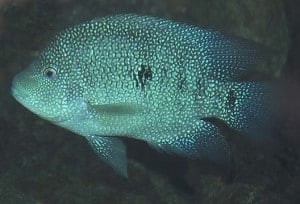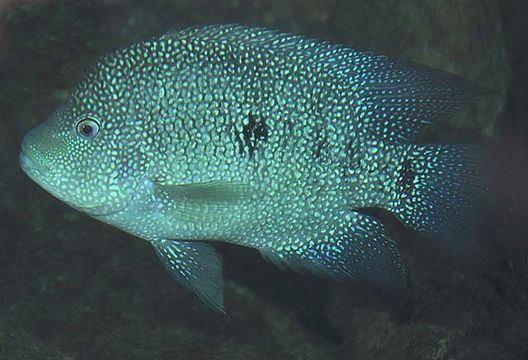
Common Name: Texas Cichlid
Scientific Name: Herichthys Cyanoguttatus
Average Adult Fish Size: 30 cm / 12 inches
Place of Origin: Its native habitat is the lower Rio Grande drainage in Texas, U.S. and north-eastern parts of Mexico.
Typical Tank Setup: Some rockwork and floating plants with the aquarium divided into several territories.
Recommended Minimum Aquarium Capacity: 75 gallon / 300 litre for one, 125 gallon / 500 litre or larger for a pair or for a community aquarium with 1 Texas cichlid.
Compatibility: Other very aggressive S. American cichlids of similar size.
Temperature: 21-24 Deg. C / 70-75 Deg. F
Water Chemistry: pH 6.5 – 8.0 with 7.0 being best
Feeding: Larger specimens need a variety of pellets and/or chunk frozen food. They will also eat smaller live fish, but this is not the best diet for them. Smaller specimens will eat flake and pelleted food suitable for their size. A varied diet is best as they eat insects, other fish, and plant matter in the wild.
Sexing: Sexing Texas cichlids can be very tricky because males and females can look very similar to each other. Generally speaking, females will be smaller and show less coloration. If you have an older male, he might develop a cranial bump. There are however reports of female Texas cichlids developing bumps as well, so this mode of sexing is not 100% reliable. Venting is the most accurate way to sex Texas cichlids.
Breeding: The Texas cichlid is a prolific species in the wild and they are easy to breed in the aquarium as well. Texas cichlids are clutch tenders and both parents will protect and care for the offspring. Provide a medium to large flat rock like slate for them to use. They are open area breeders and prefer well-oxygenated water.
Additional Information: Texas cichlids come in varying colors which can range from blue, green, or red. Some are true Texas cichlids and some are hybrid varieties. Temperament can range from moderately aggressive to extremely aggressive. Tank mates either need to be able to defend themselves or have the space to safely retreat.


Related Posts
Croaking Gourami – Trichopsis vittatus
Benthochromis Tricoti
Large-eyed Mouthbrooder – Callochromis Macrops